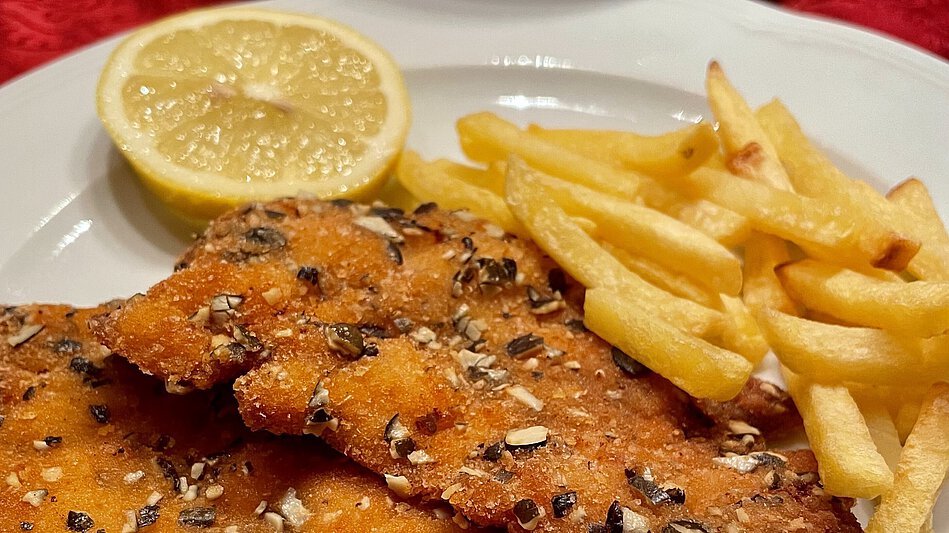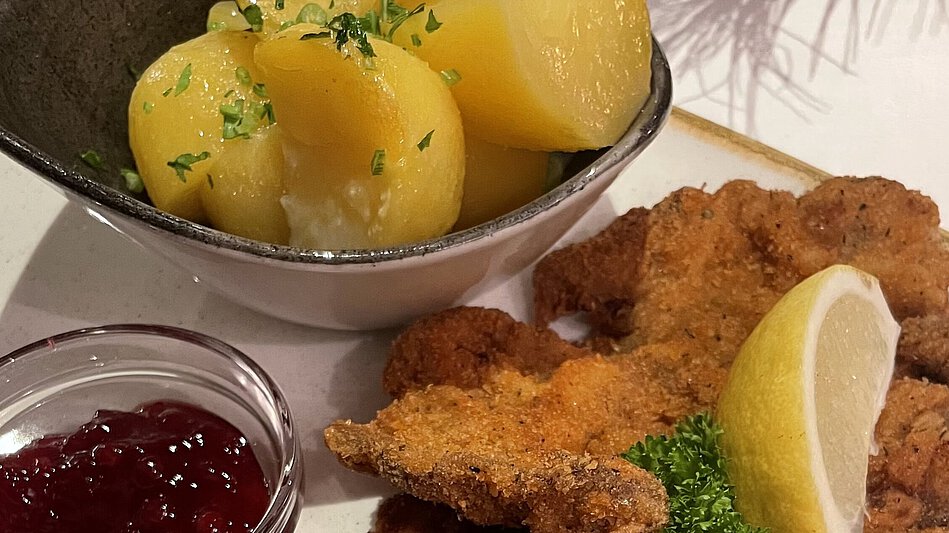![[Translate to English:] [Translate to English:]](/fileadmin/_processed_/3/c/csm_50609_c__WienTourismusPaul_Bauer_84c7bc869a.jpg)
THE WIENER SCHNITZEL
Crisp, golden-brown fried veal, the breading made from flour, egg, and breadcrumbs, traditionally served with perfectly seasoned potato salad with lamb’s lettuce and often garnished with a fresh slice of lemon... the Viennese love their traditional Wiener Schnitzel!
When referring to the original Wiener Schnitzel, it is typically made from veal. However, excellent pork schnitzels are now also offered.
Originally, Wiener Schnitzel was only eaten on holidays like Christmas, New Year’s, and at weddings. It wasn’t until much later that schnitzel became a typical Sunday dish.
But where does the Wiener Schnitzel actually come from?
What we now call the “Wiener Schnitzel” is relatively young, having originated in the 19th century. The first recipe for it can be found in Maria Neudecker's "Allerneuestes allgemeines Kochbuch" (1831) as “Wiener Schnitzel made from veal.”
There are several interesting and often debated theories about the origin of the Wiener Schnitzel:
The most widely spread theory suggests that the Wiener Schnitzel is based on the Italian dish Cotoletta alla Milanese, a breaded veal cutlet. According to this theory, Joseph Radetzky supposedly brought it back to Vienna after his stationing in Italy in the 19th century, where it was further developed. However, this theory is historically quite disputed.
Another theory suggests that the Wiener Schnitzel originally comes from Ottoman cuisine, which arrived in Vienna via Hungary and other parts of the Habsburg Monarchy. The Ottomans enjoyed breading and frying food, which could have served as the basis for the schnitzel’s breading technique.
The theory most loved by the Viennese is that the Wiener Schnitzel was developed independently in Vienna. Viennese cuisine has always focused on rich, hearty dishes, influenced by the city's proximity to Hungary, Bohemia, and Moravia. The technique of breading and frying in clarified butter may have been a local innovation to make the meat crispy and flavorful.
1. Plachutta's Gasthaus zur Oper
HOP ON HOP OFF Station: Stop 1 - State Opera - Yellow & Blue Line
Address:Walfischgasse 5-7, 1010 Vienna
Located directly across from the Vienna State Opera, Gasthaus zur Oper is a symbiosis of modern design and Viennese tradition. The original Wiener Schnitzel, made from the finest veal, and other classic Viennese dishes are the heart of the culinary offering.
2. Oswald & Kalb
HOP ON HOP OFF Station: Stop 13 - Museum of Applied Arts - Red & Blue Line
Address:Bäckerstraße 14, 1010 Vienna
Step into the charm of the old university district near St. Stephen's Cathedral. The cozy vaulted space from the 16th century, beautiful wood paneling, and simple Thonet chairs all invite you to enjoy a pleasant evening with family, friends, or business partners.
3. Meissl & Schadn at Grand Ferdinand
HOP ON HOP OFF Station: Stop 15 - Strauss Monument - Red & Blue Line
Address: Schubertring 10–12, 1010 Vienna
Meissl & Schadn, a name surrounded by countless legends, has returned to Vienna's gastronomic scene. The elegant Grand Ferdinand hotel on Ringstrasse has provided a fitting home for the “new” Meissl & Schadn since 2017.
4. Zum schwarzen Kameel
HOP ON HOP OFF Station: Stop 12 - DDSG City Cruises - Red & Blue Line
Address: Bognerstraße 5, 1010 Wien
The cuisine at the Schwarzes Kameel is deeply rooted in Viennese tradition. Chef Werner Pichlmaier celebrates unpretentious, high-level cooking, serving classic dishes subtly developed for today’s tastes.
5. Eugen21
HOP ON HOP OFF Station: Stop 33 – Museum of Comtemporary Art – Yellow Linie
Address: Arsenalstraße 10, 1100 Wien
In the heart of Vienna, the charming “Eugen21” restaurant offers a special culinary experience with modern Austrian cuisine: While the ANdAZ schnitzel represents a new interpretation of a traditional dish, the Beef Tatar remains a classic.
6. Gmoakeller
HOP ON HOP OFF Station: Stop 15 – Strauss Monument – Red & Blue Line
Address: Heumarkt 25, 1030 Wien
Gmoakeller is known for traditional Viennese tavern cuisine with a strong touch of modernity.
7. Restaurant Rote Bar
HOP ON HOP OFF Station: Stop 1 – State Opera – Gelb & Blue Line
Address: Philharmonikerstraße 4, 1010 Wien
At Restaurant Rote Bar, you'll be spoiled with the finest Viennese classics. Popular Austrian dishes made with regional products are created and prepared with care.
8. Figlmüller
HOP ON HOP OFF Station: Stop 13 - Museumpf Applied Arts - Red & Blue Line
Address:Bäckerstraße 7, 1010 Vienna
From the beginning, Figlmüller represented the unique Viennese lifestyle: a tavern where you can chat and celebrate, with a fine menu and selected wines. And of course, the original schnitzel interpretation.
Under the leadership of Hans Figlmüller senior, Figlmüller schnitzel gained international fame, cementing the restaurant's reputation as a culinary ambassador of Vienna.
9. Zum weißen Rauchfangkehrer
HOP ON HOP OFF Station: Stop 15 - Strauss Monument - Red & Blue Line
Address:Weihburggasse 4, 1010 Vienna
While elsewhere, you might have to climb a chimney to see St. Stephen's Cathedral, not at Zum Weißen Rauchfangkehrer. Here, from the garden terrace or the popular "1er-Tisch" (table), you can view the "Steffl" without any risk.
A place where the aroma of Austrian cuisine mixes with music, culture, and the joy of living.
10. Restaurant Eckel
HOP ON HOP OFF Station: Stop 47 – Votiv Church, Red & Green Line
Adresse:Sieveringer Straße 46, 1190 Vienna
Here, you can expect simple, good bourgeois Viennese cuisine made from the most natural ingredients.
Vegan Alternatives to the Classic Wiener Schnitzel – Is that even possible?
When it comes to Wiener Schnitzel, most people think of a crispy, delicious veal schnitzel. However, more and more places are offering schnitzels for those who want or need to follow a vegan diet.
So, if you avoid animal products, you can still enjoy this delicious and crispy dish:
• Velani, Schönbrunner Straße 235, 1120 Vienna
• Bioparadies, Altgasse 23A/1/1, 1130 Vienna
• Schlicht Vegan, Veronikagasse 17, 1160 Vienna
• Gasthaus am Predigtstuhl, Oberwiedenstraße 34, 1170 Vienna
Interesting Facts and Trivia about the Wiener Schnitzel
- The Wiener Schnitzel is protected by Austrian law, which stipulates that it must be made from veal. Using pork instead of veal is often called "Wiener Art" (in the style of Vienna) to distinguish it from the traditional veal version.
- The largest Wiener Schnitzel ever made weighed over 500 kilograms and was prepared in Germany in 2009.
- On average, Austrians eat 30 Wiener Schnitzels per year, making it a true classic for both young and old. This famous Austrian dish is a must for anyone visiting Austria!
Bon appétit!

